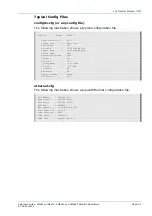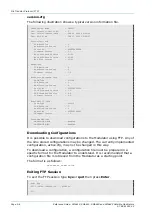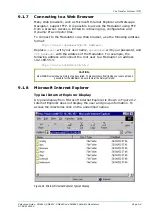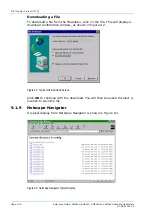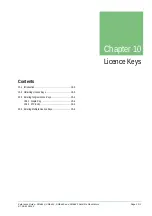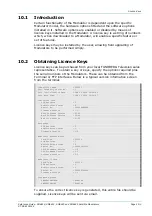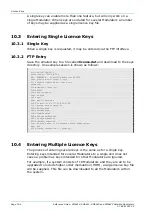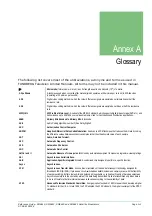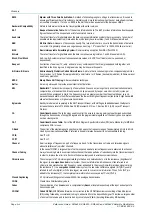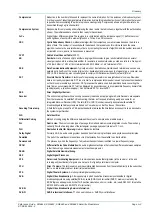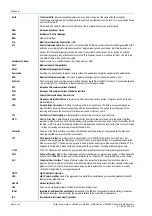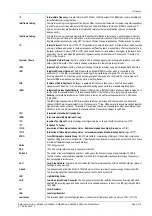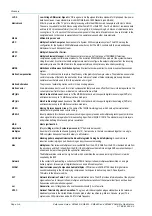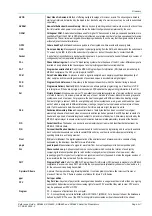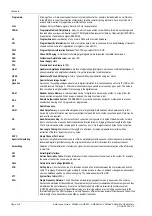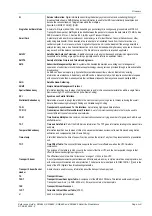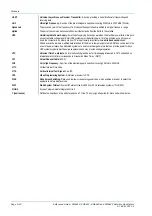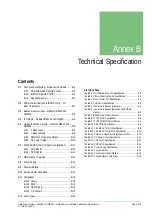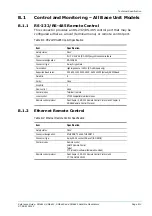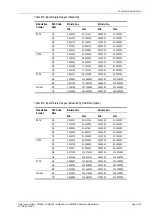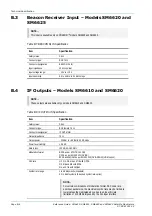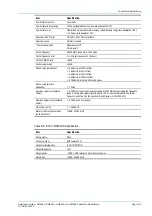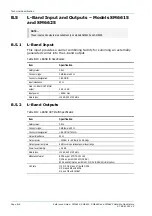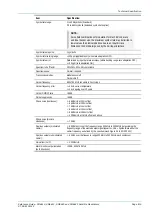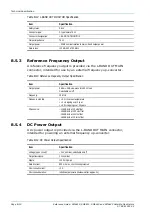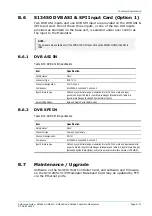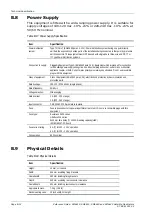
Glossary
Reference Guide: SM6610, SM6615, SM6620 and SM6625 Satellite Modulators
Page A-7
ST.RE.E10152.2
NVOD
Near Video On Demand:
Method of offering multiple showings of movies or events. The showings are timed to
start at set intervals, determined by the broadcaster. Each showing of a movie or event can be sold to subscribers
separately.
NVRAM
Non-volatile Random Access Memory:
Memory devices (permitting random read / write access) that do not lose
their information when power is removed. Stores the default configuration parameters set by the user.
OFDM
Orthogonal FDM:
A modulation technique used for digital TV transmission in Europe, Japan and Australia; more
spectrally efficient than FDM. In OFDM, data is distributed over a large number of carriers spaced apart at precise
frequencies. The carriers are arranged with overlapping sidebands in such a way that the signals can be received
without adjacent channel interference.
OPPV
Order ahead Pay Per View:
An advance purchase of encrypted one-time events with an expiry date.
OSD
On-screen display:
Messages and graphics, typically originating from the SMS, and displayed on the subscriber’s
TV screen by the IRD, to inform the subscriber of problems or instruct the subscriber to contact the SMS.
Packet
A unit of data transmitted over a packet-switching network. A packet consists of a header followed by a number of
contiguous bytes from an elementary data stream.
PAL
Phase Alternating Line:
A colour TV broadcasting system where the phase of the R-Y colour-difference signal is
inverted on every alternate line to average out errors providing consistent colour reproduction.
PAT
Program Association Table:
Part of the MPEG-2 Program Specific Information (PSI) data and is mandatory for
MPEG-2 compliance. The PAT points (maps) to the PMT.
PCM
Pulse Code Modulation:
A process in which a signal is sampled, each sample is quantised independently of
other samples, and the resulting succession of quantised values is encoded into a digital signal.
PCR
Program Clock Reference:
A time-stamp in the transport stream from which the Decoder timing is derived.
PDC
Programme Delivery Control
(VBI)
:
A Teletext service allowing simple programming (i.e. VideoPlus) of VCR
recording times. If the desired program is rescheduled, PDC updates the programming information in the VCR.
Pel
Picture Element:
Also known as a pixel. The smallest resolvable rectangular area of an image either on a screen
or stored in memory. On screen, pixels are made up of one or more dots of colour. Monochrome and grey-scale
systems use one dot per pixel. For grey-scale, the pixel is energised with different intensities, creating a range
from dark to light (a scale of 0-255 for an eight-bit pixel). Colour systems use a red, green and blue dot per pixel,
each of which is energised to different intensities, creating a range of colours perceived as the mixture of these
dots. If all three dots are dark, the result is black. If all three dots are bright, the result is white.
PES
Packetised Elementary Stream:
A sequential stream of data bytes that has been converted from original
elementary streams of audio and video access units and transported as packets. Each PES packet consists of a
header and a payload of variable length and subject to a maximum of 64 kbytes. A time-stamp is provided by the
MPEG-2 systems layer to ensure correct synchronisation between related elementary streams at the Decoder.
PID
Packet Identifier:
The header on a packet in an elementary data stream, which identifies that data stream. An
MPEG-2 / DVB standard.
PIN
Personal Identification Number:
A password used to control access to programming and to set purchase limits.
Each subscriber household can activate several PINs and may use them to set individual parental rating or
spending limits for each family member.
Pixel
PIX
(picture)
El
ement: The digital representation of the smallest area of a television picture capable of being
delineated by the bit-stream. See
Pel
for more information.
pk-pk
peak to peak:
Measurement of a signal or waveform from its most negative point to its most positive point.
PLL
Phase-Locked Loop.
A phase-locked loop is a control system which controls the rotation of an object by
comparing its rotational position (phase) with another rotating object as in the case of a sine wave or other
repeating signal. This type of control system can synchronise not only the speed, but also the angular position of
two waveforms that are not derived from the same source.
PMT
Program Map Table:
Part of the MPEG-2 Program Specific Information (PSI) data and is mandatory for MPEG-2
compliance. Each service has a PMT, which lists the component parts (elementary streams of video, audio, etc.)
for the various services being transmitted.
P-picture/P-frame
A picture / frame produced using forward prediction. It contains predictions from either previous I frames or
previous P frames. The P frame is used as a reference for future P or B frames.
ppm
Parts per million.
PPV
Pay Per View:
A system of payment for viewing services based on a usage / event basis rather than on on-going
subscription. Subscribers must purchase viewing rights for each PPV event that they wish to view. PPV events
may be purchased as IPPV
or OPPV.
Program
PC - A sequence of instructions for a computer.
TV - A concept having a precise definition within ISO 13818-1 (MPEG-2). For a transport stream, the timebase is
defined by the PCR. The use of the PCR for timing information creates a virtual channel within the stream.
Содержание SM6610
Страница 10: ...Introduction Page 1 2 Reference Guide SM6610 SM6615 SM6620 and SM6625 Satellite Modulators ST RE E10152 2 BLANK...
Страница 138: ...Equipment Description Page 7 2 Reference Guide SM6610 SM6615 SM6620 and SM6625 Satellite Modulators ST RE E10152 2 BLANK...
Страница 172: ...Licence Keys Page 10 2 Reference Guide SM6610 SM6615 SM6620 and SM6625 Satellite Modulators ST RE E10152 2 BLANK...

